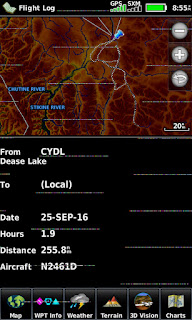I’ve never had a strong desire to fly a private plane to Alaska -- or even drive a car to Alaska. It has always seemed like a long way to go through a lot of nothing. I have, however, wanted to land a plane in Alaska. I always sort of imagined it as a "Sandra and I take an airliner for an Alaska vacation and one day I go rent a plane" kind or event. I have also been wanting to build up tailwheel experience in the T-6 / SNJ / Harvard. I got some time in one a couple years back before I had a tail-wheel endorsement, and logged one landing with an instructor. This year for my birthday, my wife gave me a gift certificate for three more hours in a T-6. We were making plans for a family California vacation and I would fly with
Aviator Flight Training (AFT) when stumbled upon a Facebook post of a guy looking for a co-pilot on a ferry trip from Vancouver Washington to Fairbanks Alaska.
I raised my virtual hand, and met
Andy Bibber, the owner of
Adventure Flight. He runs a tail-wheel only flight school out of Northern California in the winter, and air tours in Fairbanks during the summer. It was time to take the planes north. Sandra agreed to I could have this adventure in place of the three hours with AFT.
 |
| loading up at Pierson |
My friend, Eric, flew me down to Pearson Airfield in Vancouver Washington on Sunday night where I met Andy in person. He’s a good guy with a strong aviation background. We planned to leave first
thing in the morning, but the big radial engine uses a lot of oil, so we are waiting for a shipment to arrive before we can leave. It was supposed to be there on Friday.
 |
| The oil arrives! |
Monday morning I am at the plane packing my things into the back and Andy calls to invite me out for breakfast, because the oil is still on a UPS truck somewhere in the Portland area. So we hung out at his in-laws and I held his new baby, and the oil finally showed up at 3:00 PM.
Vancouver WA to Bellingham WA
 |
| The Columbia River, separating Oregon from Washington |
We finished loading the plane, filled it with gas and departed to the west, turning right and following the railroad tracks north and the joining the Columbia river, then over Chehalis, Olympia, up the Puget Sound to the west of Seattle, and finally my second T-6 landing at Bellingham.
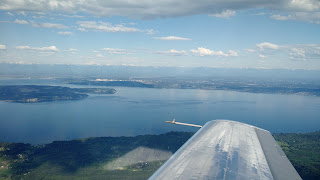 |
| My home airport from the other side of the Puget Sound |
We refueled and went into the FBO to call Canadian Customs. Our next leg was to take us up the Hope Valley to Prince George, but we learned that customs there was already closed for the day. We would have to clear customs someplace else. Andy inquired about all the airports along the Hope and Fraser Valleys, looking for a place to clear customs. Finally all the way back at Vancouver BC we found an open Customs office. But the office needed two hours notice before our arrival. So for the second time, we sat and waited before departing on our 20 minute flight to across the border.
Bellingham WA to Vancouver BC
 |
| Coal terminal at Vancouver BC |
Since the plane's radio only works from the front seat, and since Andy is familiar with the border crossing and customs procedures, I suggested he fly front seat on this leg. It was a short but pretty hop over Boundary Bay, and then circling out west of Vancouver before coming back in to land. We were then directed to the customs area. A big area on the ramp delineated with a red outline on the ground. We parked, shut-down, and called customs. No one came out, no one looked at us, they just cleared us. We both wondered why we couldn’t have called the same guy from Prince George. Oh well.
Vancouver BC to Prince George BC
Even though dark was rapidly approaching we decided to press on over the mountain range between us and Prince George. It is rugged harsh terrain. I would not want to go down in there. It is beautiful, but intense.
We climbed out to 10,500 feet. This was the first real demonstration of the power of the plane’s 600 horsepower R-1340 engine. It wasn’t even struggling at 10,500 feet. In level cruise with a bit of a tail-wind we were making 175 to 180 knots over the ground. Big growly radial engine, eating sky ahead and spraying oil out behind.
Flying the SNJ in the dark allows us to see the exhaust flame's reflection off of the wing joint fairing and adjust the fuel air mixture by color.
At 10:00 PM that night we were lining up for my third T-6 landing. I bounced once, and then pinned the main wheels on the runway. With the heavy airframe, the high approach speed, and the ineffective brakes, I rolled past my turn off. We turned around on the runway, taxied back, and shut the plane down at Esso Aviation for the night. My first landing in Canadian Province, and even better, my first landing in a foreign country.
Prince George was having some big to-do so there were lots of big 4x4 trucks. I think one of the mills or factories or something had gone out of business and there was an equipment auction scheduled for the next day. For a small town so far north, in the middle of what seemed like nowhere, this is a pretty lively city!
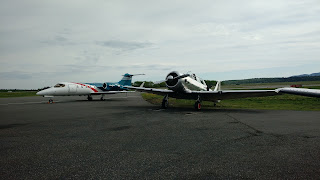 |
| Prepping for our morning departure |
The next morning we grabbed some breakfast and a cab to get us back to the plane. The old SNJ drew attention wherever we went. I have to admit it was nice to be the guy getting the attention rather than the one giving it. Our preflight included giving the plane a couple more gallons of oil to spray out the back, and replenishing the hydraulic fluid. Back inside the FBO a couple of Learjet pilots were asking about the fluids. "Does that thing hold like eight gallons?"
"Ten." I replied.
"Is it normal for it to need that much oil?" He asked.
"Yeah, it uses about three quarts an hour."
Look of shock. "And the hydraulic fluid?"
"Yep. It leaks somewhere."
The Lear pilot pressed on. "Where does it go? Why does it leak?"
"Look," I said, "The plane is 70 or 80 years old. When you are that old, you are going to leak too."
The other Learjet pilot and the FBO staff laughed at the poor guy.
Prince George BC to out-of-choices.
We had been watching a weather front moving in from the west, and the edge of it was producing scattered snow showers along our path towards Dease Lake. We took off into clear skies and settled into a cruise at 8,500 feet.
Far in the distance we could see a small knot of clouds on the horizon, but space on either side. We flew on, aiming for the left side of the clouds ahead. We passed the first small, isolated snow shower on our right. We began working our way north and west, but soon our route was blocked at we made a 180 degree turn back out. We flew northeast finding some more openings, but soon that was blocked, and we went back northwest. Blocked again. We were not getting around the snow showers, and our fuel is limited. We radioed Dease Lake to check the weather and found no encouraging reports. Our only option was to climb above the snow showers and divert to Watson Lake. It was further, and would tax our fuel supply, but the weather was favorable there.
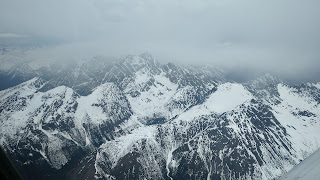 |
| Snow making things tougher |
We found less bad reports at Watson Lake, decided we had to commit or we would end up out of options, out of ideas, out of fuel and landing in the remote wilderness of northern British Columbia. Below us at the time was a reservoir with a gravel strip near by. I mentally tucked that away as better than landing in the trees. There was no route out at the current altitude so we decided to go over the clouds to the north.
And commit we did. North to Watson Lake YT we pressed on. Up we went. With the plane pointed up hill, the fuel sloshes to the rear of the tank, and pick-up in the front of the right main began to suck air and the engine sputtered. This was new for me. I’ve never had a tank run dry in a plane. A quick switch to the left main had those 600 horsepower pulling us easily up to 14,000 feet to clear the clouds ahead.
We went GPS direct to Watson Lake skimming across the clouds, we switched back to the right main where the fuel had sloshed back forward to give us another 10 or 15 minutes of flying. We were making good time with the GPS showing ground speeds between 175 and 180 kts, and finally the right main went completely dry. So back to the left main tank we went, and pressed on. We were still on the left main, and the reserve tank would give us about half an hour of flying time, and the GPS was showing about 40 minutes to the airport. So as long as we had 15 or 20 minutes of fuel in the left main, we would make the airport. Plus we can glide a long way from 14,000 feet.
But this is not good. We had flown ourselves into a situation where we had no alternates. Either this worked or... I’d prefer to not think about it.
 |
| Watson Lake's terminal |
As we moved north, the clouds below us thinned as forecast, and the tops became lower. We could see the terrain through gaps in the clouds well below us. We we getting into the lower valley as confirmed by the GPS and charts. We could make this. As the cloud tops got lower we pointed the plane down hill and headed for thicker air. With the plane sliding down hill, and a little extra push from the wind we were closing on the airport at over 200 kts. The distance was melting away.
We didn’t want to spend any time maneuvering so we lined ourselves up for a straight in approach to the runway, dropped the gear, and I plopped it hard onto the runway again. We were both glad to be on the ground next to a gas pump.
Watson Lake to Whitehorse
 |
| The Yukon River |
We filled both fuel tanks, the oil tank, got a weather briefing, and stood around for a few minutes. Whitehorse YT was right around 2 hours away. After the last leg, it was a welcome break before a short trip. The flight was uneventful. At first we followed the Alcan highway, but soon the direct route parted ways with the road. We played in the clouds, doing a little “yankin’ and bankin’” around the edges, over the tops, and between the cloud valleys. Where there were no clouds the vast wilderness stretched out below with winding rivers, rolling hills and beautiful colors. Before long we were coming around the last ridge to pick up the Alcan highway for the final five miles into the airport. There was a gusting 15 knot direct crosswind, and as much trouble as I had been having with getting this thing on the ground, I knew to let Andy take the strong crosswind landing.
Whitehorse to Fairbanks
 |
| Right Downwind departure from Whitehorse |
Customs back into the United States gave us the same timing troubles that Canada did. But this time the nearer airport’s customs would be off-duty requiring another long leg to the on-duty customs in Fairbanks. We filled the tanks, filled the oil, and pushed the throttle forward for the final leg. I took off with the same crosswind Andy had just fought on the way in, and got the plane up and turned back towards the Alcan highway to point it towards Fairbanks. This would be a 3 hour leg, and I was starting to get stiff from sitting in the seat that was built with 1933’s knowledge of ergonomics. My behind was getting tired.
And it was cold. I had on wool socks, jeans, 2 shirts, a flight suit, and a pair of gloves. There is no heat in this plane. It mostly warms from the sun shining through the “greenhouse canopy.” But little sun we were getting was not keeping up with the cold leaky cockpit. My hands were starting to ache from the cold. I would sit on one and fly with the other, and then trade to warm up the cold one. I would tuck them into my armpits or press them up on my body to get them warm. My toes were getting stiff. I was getting stiff.
 |
| Note the line on the hill. Left side Canada, Right side Alaska |
Andy was pointing out the sights. The line carved into the hills delineating Canada from Alaska, a lake where his friends have a cabin, a mountain range where everything was over 14,000 feet, a valley leading to Valdez, a valley leading out to Anchorage, more of the Alcan Highway, and the Trans-Alaska Pipeline.
 |
| Tanana River and the Trans-Alaska Pipeline |
I recall as a kid my Dad’s employer had a contract to build some of the stands that hold the pipe up off the ground and Dad spending months welding the frames together. Seeing the pipeline below reminded me of him, and his of legacy of infrastructure projects he worked on, and it makes me wonder if any of the computer code I have worked on will still matter in the decades ahead. My work is so ethereal, it sometimes feels like a snowman you work hard to complete, only to have it melt a couple days later when the wind brings in the next batch of warm air.
At the edge of the TRSA
The arrival to the Fairbanks area routed us through several Military Operation Areas, and two military airports. About 30 miles south east we called up the Terminal Radar Service Area (TRSA) controllers. TRSAs are odd things. They provide radar services for arrivals into the areas, but pilot's participation is optional. To our right we passed Eielson Air Force Base, and then Fort Wainwright / Ladd Army Airfield.
 |
The planes by the float pond reminded me of
an airplane homeless encampment |
Fairbanks International is an eclectic airport with a couple of long runways for the airliners. But it also has a “ski strip” of gravel that extends runway 20L, and a float pond between ski strip and 20R. A mish-mash or new, used, and consumed airplanes are littered about the ramp. Here 737s peacefully co-exist with weather-worn Cessnas and Pipers.
I had to make a couple passes at the runway to figure out the layout of the runways, and at first I lined up on a taxiway to the left of the ski strip, and by the time I got lined up on the runway, I was behind the plane and bounced it, I slammed the power back forward and went around for a second try. On the second pass, I managed to keep the left wing low for the crosswind, and still set the plane down hard -- again. With the power off and the tail pinned down, the end of the runway closing fast, I applied the marginally effective brakes, and heard Andy in my headsets saying "We are going off the end!" Then I stood on the brakes. With my legs extended straight out, and my back pressed hard against the back of the seat, I got the plane stopped feet from the threshold and turned off to the left towards the general aviation (GA) ramp.
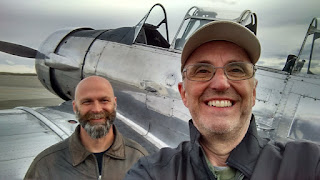 |
| On the ground in Fairbanks, clear of customs. |
A deep breath and a call to the ground controllers and we were taxiing back across both runways to customs on northwest side of the airport. The customs agent came out and met us, and escorted us back into the building where we were interviewed and filled out the immigration paperwork. I found it odd that as an American citizen to get into Canada all that happened was the customs agent talked to Andy on the phone. To get back into America we had to get out of the plane, be escorted in, interviewed, and fill out forms. It was easier to get into another country than it was to get back into my own country. On the way back out to the plane we snapped a quick photo.
We taxied back to the GA ramp where Andy’s friends came out to greet him. Inside we filled out the last of our log books, Andy signed off my Biennial Flight Review (BFR), and I booked the next Delta Airlines flight back to Seattle.
EPILOG and Full Photo Album
One new friend, two days in the SNJ-4, 11.9 hours of flying, seven gallons of oil, gasoline measured in liters, 24 more months of flying on one BFR, two new provinces, one new country, and one new state. 34 down, 16 to go. One AWESOME adventure.
Full
photo album.
 |
| Checking off Alaska. 34 down 16 to go |



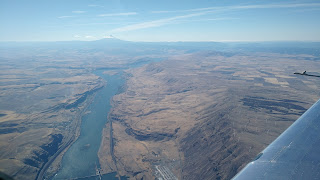




 We spent the next couple hours unpacking and sorting our gear from the plane, and tucking the SNJ into the hangar with its stable-mates. I booked a flight home for the next morning.
We spent the next couple hours unpacking and sorting our gear from the plane, and tucking the SNJ into the hangar with its stable-mates. I booked a flight home for the next morning. 













